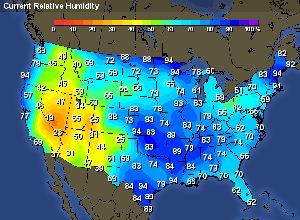Viola Humidity
 It's good to be aware of seasonal changes which can
change the relative humidity and/or the sound of your
viola. There are several related factors with
humidity and dryness that can not only endanger the
physical well being of your viola, but in most cases
will adversely change the tone and response of your
instrument. It's good to be aware of seasonal changes which can
change the relative humidity and/or the sound of your
viola. There are several related factors with
humidity and dryness that can not only endanger the
physical well being of your viola, but in most cases
will adversely change the tone and response of your
instrument.
A couple of things. First, most everyone
knows that in much of the world (N. America, Europe,
most of Asia and S. America too) it can get pretty dry
in the winter. If you look closely at some of the
older violas, you will occasionally run across one that
has some kind of repaired crack on it. This is not
always a 'ding' in the value, but in some cases, a bad
sound post crack on the top or back can greatly devalue
it.
Besides the cracking issue, the dry air tends to
'tighten' the response of the instrument. This is
why some players keep humidifiers on in their studios or
home. Most of the time, keeping one of the little
green Dampits in the instrument (or even two) will get
the instrument through the driest patches of the cold
winter months. A viola that gets too dry will dry
the wood and keep it from vibrating at its fullest
capabilities. Often there is shrinkage involved
with drying wood that will push down or contort the top
enough that it interferes with the nice symmetrical
balance of the top and f-holes in relation to the
location and proper fit of the viola's soundpost.
What to look and listen for. If you are
concerned about how your viola is doing in the winter
(or even summer) there are some easy telltale signs to
look for:
- the strings are a lot lower than usual.
The strings tend to get too low in the dryer winter
months. Little minute (previously unnoticed
imperfections in the fingerboard) get more
noticeable with clacking or buzzing
- there is a buzz in the sound somewhere.
Sometimes the dry air will cause a seam to open.
That's not bad, but a good (pressure valve) way of
letting you know. Seam repairs (gluing) is
quick and easy.
- the instrument is not as responsive as you know
it can be. Here those of you that just bought
a new instrument (new or old) but 'new' to you and
haven't been through a winter yet. Watch out!
You don't want to wait and see if you noticed some
of these traits for dryness. It's good to take
the viola in, and just to be on the super safe side,
some luthiers will deliberately open some seams to
relieve that tight pressure. This is easy,
quick and much better and cheaper than getting a
more serious crack on the viola.
- You didn't buy your new Viola strings from Viola-Strings.com and now God is punishing you!
(Ok, maybe not, but this just proves that we have a
good sense of humor around here!!)
| Manufacturer: |
Brands: |
| Combined Custom Sets for Viola |
You name it...we combine it! |
| Pirastro Viola Strings |
Evah Pirazzi, Passione, Obligato, Gold
Label, Olive, Chorda, Eudoxa and Paranito
and Tonica |
| Thomastik-Infeld Viola Strings |
Spirocore, (most popular
are the C and G's!) Dominants, Vision |
| Larsen Viola Strings |
Offered in light, medium, heavy gauge. |
| D'Addario Viola
Strings |
Helicore, Kaplan and Prelude cello
strings |
| Jargar Viola Strings |
Jargar Supremes, come in light, medium
and heavy gauges. |
| Prim |
Offered in light, medium and orchestra
heavy gauge. |
| Warchal |
Brilliant and Karneol (These are
new and getting popular.) |
|
We also have some helpful and interesting links about individual string brands, comparisons and some practical related viola information to read:

|


 It's good to be aware of seasonal changes which can
change the relative humidity and/or the sound of your
viola. There are several related factors with
humidity and dryness that can not only endanger the
physical well being of your viola, but in most cases
will adversely change the tone and response of your
instrument.
It's good to be aware of seasonal changes which can
change the relative humidity and/or the sound of your
viola. There are several related factors with
humidity and dryness that can not only endanger the
physical well being of your viola, but in most cases
will adversely change the tone and response of your
instrument.